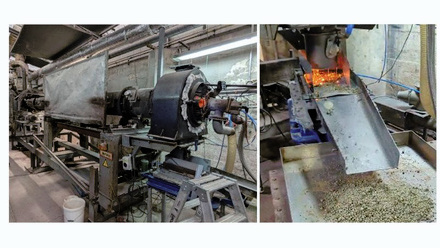Uses of aggregates
As a basic raw material aggregates can be put to many uses, although certain tasks may require a specific type of aggregate.

The largest proportion of primary aggregates is used to manufacture concrete ( approx. 36%), with a further 10% used to manufacture the cement that is also used in the concrete. Use in roads accounts for the second largest category at just over a quarter, while a fifth of aggregates were used in other construction uses and fills. Another 2% were used for railway ballast.
However, materials that are suitable for use as aggregates can also be used to manufacture other products thus industrial and other uses amounted to 6% with the remainder split between the manufacture of mortar (4%), glass (1%) and use in agriculture (1%).
Constructional in general
Aggregates are used in construction to provide drainage, fill voids, protect pipes, and to provide hard surfaces. They are also used in water filtration and sewage treatment processes. Water will percolate through a trench filled with aggregate more quickly than it will through the surrounding soil, thus enabling an area to be drained of surface water. This technique is frequently used alongside roads in order to disperse water collected from the asphalt surfacing.
Voids created around the foundations of buildings during construction are filled with aggregate because it is easier to compact than the original soil that was removed, resulting in a more solid finish that will support the structure. Aggregates generally are not affected by the weather as much as soils, particularly clay soils, and will not suffer from shrinkage cracking during dry spells.
Pipes laid to convey treated water, or as conduits for cables, need to be protected from sharp objects in the ground and are therefore laid on, and surrounded by fine aggregate before trenches are backfilled.
Unpaved roads and parking areas are covered in a surface layer of aggregate to provide a more solid surface for vehicles, from cycles to lorries. This prevents the vehicles from sinking into the soil, particularly during wet weather.
Groundwater is filtered naturally through aquifers, often layers of sand and gravel, and only needs to be disinfected with chlorine before it is safe to use. This natural process can be replicated in treatment works to remove suspended solids from surface or stored water, before disinfection. In addition, sand beds are used during the last stages of sewage treatment works as a final filter and cleaning process before the water is released into watercourses. In some cases reed beds are used at this stage, where the reeds will be grown on gravel.
Concrete
Concrete is a mixture of aggregates, cement and water. The purpose of the aggregates within this mixture is to provide a rigid skeletal structure and to reduce the space occupied by the cement paste. Both coarse aggregates (particle sizes of 20mm to 4mm) and fine aggregates (particle sizes less than 4mm) are required but the proportions of different sizes of coarse aggregate will vary depending on the particular mix required for each individual end use.
The smaller the aggregate size the greater its surface area and the more cement will be required to bind it all together, resulting in a higher cost. However, in general terms, the greater the quantity of cement used the stronger the concrete will be. Therefore, a balance needs to be made between the strength requirements of the end use and the price that the customer will be willing to pay.
Concrete has been used, in some form, since Roman times and it is the most universal construction material around. Usually, it is supplied in one of two main forms - precast - blocks, tiles, pipes, bridge beams, flooring systems or ready-mixed - as a liquid paste ready for pouring.
It is used for the foundations, walls, floors, roofs, and partitions of buildings, as well as bridges, dams, power stations and many other kinds of physical structures. Often it is used in conjunction with other structural materials such as steel or brick.
By controlling and modifying the proportions of the basic constituents, concrete is also highly adaptable and a wide variety of specialist concretes have been developed for particular uses.
Asphalt and roadstone
This category includes not just roads, but also pavements, airport runways, school playgrounds, car parks, most footpaths or cycleways, and other similar structures. Although each type of structure will require some variation in the material, it is useful to look at the basic structure of roads because they represent the bulk of the aggregate use in this category.
The subgrade represents the natural soil, which will be compacted before the road construction starts. The capping layer is an optional layer, used when the local soils require extra strength, and it is not coated with bitumen. The sub-base is the main uncoated roadstone layer and its role is to give strength and act as a solid platform for the layers above.
The binder course and surface course are commonly called asphalt or tarmacadam. They consist of coarse aggregates, with particle sizes typically between 2mm to 28 mm, and fine aggregates, with particle sizes of less than 2mm, mixed with a bitumen binder and occasionally some additional filler if required. The exact sizes required for the coarse aggregates will depend on the particular use and the asphalt recipe specified.
The binder course is the main load-bearing layer and provides an even plane for the surface course.
The surface course provides the road with protection from the weather because water ingress would be very destructive, but also gives the final running surface that must be resistant to abrasion and skidding.
Increasingly, proprietary mixes are being developed known as thin surfacing or stone mastic asphalt which use cellulose fibres or specialist binders to obtain higher strengths with thinner layers of asphalt. These materials provide increased resistance to deformation where traffic density is high and reduce surface water spray and vehicle noise.
Mortar
Mortar consists of sand, cement and water. In some circumstances lime may also be added, together with admixtures which are chemicals to control setting and workability and/or pigments if required. They are used to bond bricks or concrete blocks together in walls and to provide weather protection or rendering. There are also types of mortar that can be used as internal plasters but these should not be confused with the more normally used, gypsum based, plasters.
Railway ballast
A fully loaded train weighs over 2,000t, added to this is the weight of the track itself and the sleepers it rests on. It soon becomes obvious that a very tough aggregate is needed to support this weight and distribute the load of a passing train to avoid serious damage to the ground, or other structures, underneath. Similarly, the railway track and sleepers must be held in place firmly and not move as a train passes along them.
Railway ballast generally consists of a tough igneous rock, such as granite, with large (40-50mm size) angular pieces that lock together. Because of the way igneous rock is formed it is highly resistant to pressure and does not break easily.
Non-aggregate uses of sand, gravel and crushed rock materials
- Cement is a substance manufactured from limestone and shale, with other minor additives, at temperatures in excess of 1,200ºC. It has unique properties - as a powder it is loose and friable, but mixed with water it hydrates into a paste and then as it dries it sets hard and binds all the surrounding particles together. Even once it seems to be solid, cement will continue to hydrate and chemically interlock so that a concrete structure will continue to gain in strength for at least a month, and in some cases three months, after formation. Virtually all of the cement produced is used in concrete.
- Agriculture, lime is taken up by plants (either crops or grass) and trees but is also naturally lost from soils through leaching by rainwater and the use of fertilisers. This can result in an increase in acidity, loss of fertility in the soil and sometimes an adverse affect on soil structure. To redress the balance, agricultural lime is applied to fields to maintain the necessary growing conditions for crops or grassland. Lime can be simply ground limestone or dolomite (which also contains magnesium) or burnt limestone, (or burnt dolomite) where the rock is heated in a kiln.
- Glass is made from melting silica sand at a high temperature, in the presence of sodium as a flux. The molten glass, at approximately 1,000ºC is poured continuously from a furnace onto a shallow bath of molten tin, where it spreads out evenly. It is then cooled quickly before crystallisation can occur.
- Industrial and other uses - limestone is used as a flux in the extraction of iron from iron ore. Iron is extracted from ore by heating in a furnace. Limestone is added so that the silicon in the ore forms a calcium silicate with the calcium carbonate that is limestone otherwise it would form an iron silicate and thus reduce the quantity of metallic iron produced. The calcium silicate, together with other impurities, forms the 'slag' and this substance can be used as a lightweight secondary aggregate.
- Sand, usually silica sand, is used to make moulds in a foundry. These are the hollow containers into which molten metal is poured to produce a casting of a particular shape. The exact type of sand used depends on the particular metal or alloy that is to be cast, but it usually contains clay and/or some other material to bind it together.
- Limestone, or calcium carbonate, also has many other uses. Ground to a fine powder it is used as a whitening agent or filler in paper, adhesives, paint, plastics, PVC, toothpaste, medical tablets and cleaning products. It is also used to provide additional calcium in vitamin and mineral supplements, flour and animal feed.







